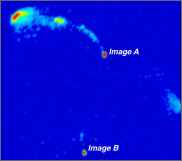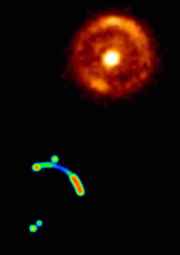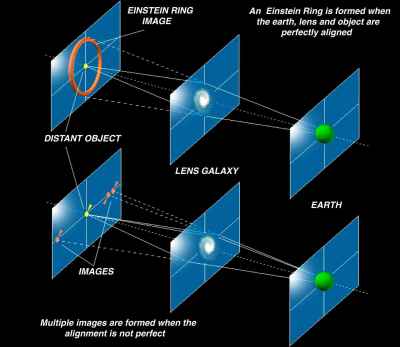
|
Gravitational Lenses |
|
One of the predictions of Einstein's Theory of General Relativity is that a massive object will distort the space around it forming what is called a Gravitational Lens. This causes light and radio waves from an object behind to follow curved paths in its vicinity, producing multiple or distorted images of the same object. In 1972, the Mark IA (now Lovell) telescope made a survey in which 800 radio sources were discovered. Follow-up observations were used to find their precise positions and thus allow optical identifications to be made. One source, 0957+561, coincided with a close pair of faint blue objects. These were observed with an optical telescope in 1979 and found to be two images of the same distant quasar - the first gravitational lens (left). Since then, with MERLIN playing a key role, many other lenses have been discovered, and it appears that approximatly one distant radio source in 500 is split into multiple images due to lensing by a foreground galaxy. If this galaxy is precisely aligned with the remote quasar, an "Einstein Ring" can be formed, several of which have now been observed (below). Hubble's Constant Gravitational lenses can provide a way of measuring the size of the universe. The paths through space by which we see the multiple images will be different and the ratio of their lengths can be determined from the geometry of the image. If the source is variable, one can determine the difference in path lengths and so calculate the distance of the quasar. This, combined with its redshift, leads to a measurement of Hubble's Constant. Values of between 61 and 69 km/s/Mpc are currently being found. The CLASS Survey This is a collaborative effort led by the Jodrell Bank Observatory and involving institutes in the USA and the Netherlands. A total of over 15,000 radio sources have been investigated from which 19 new lenses have, so far, been found. The Cosmological Constant When Einstein first tried to apply his General Theory of Relativity to what he thought was a static, unchanging universe, he had to incorporate a term called L, the cosmological constant. This represents a repulsive force which can overcome gravity at great distances. When it was realised that the Universe was expanding this term was no longer required and was soon dismissed by cosmologists. Einstein said that it had been the "greatest blunder" of his life! However it is beginning to appear as if this repulsive force might exist after all, and the CLASS census of the percentage of remote radio sources that have been gravitationally lensed will soon tell us where the truth lies!
|


